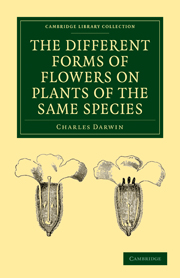Book contents
- Frontmatter
- Contents
- INTRODUCTION
- CHAPTER I HETEROSTYLED DIMORPHIC PLANTS: PRIMTULACEÆ
- CHAPTER II HYBRID PRIMULAS
- CHAPTER III HETEROSTYLED DIMORPHIC PLANTS–continued.
- CHAPTER IV HETEROSTYLED TRIMORPHIC PLANTS
- CHAPTER V ILLEGITIMATE OFFSPRING OF HETEROSTYLED PLANTS
- CHAPTER VI CONCLUDING REMARKS ON HETEROSTYLED PLANTS
- CHAPTER VII POLYGAMOUS, DIŒCTOUS, AND GYNO-DIŒCIOUS PLANTS
- CHAPTER VIII CLEISTOGAMIO FLOWERS
- INDEX
CHAPTER V - ILLEGITIMATE OFFSPRING OF HETEROSTYLED PLANTS
Published online by Cambridge University Press: 05 July 2011
- Frontmatter
- Contents
- INTRODUCTION
- CHAPTER I HETEROSTYLED DIMORPHIC PLANTS: PRIMTULACEÆ
- CHAPTER II HYBRID PRIMULAS
- CHAPTER III HETEROSTYLED DIMORPHIC PLANTS–continued.
- CHAPTER IV HETEROSTYLED TRIMORPHIC PLANTS
- CHAPTER V ILLEGITIMATE OFFSPRING OF HETEROSTYLED PLANTS
- CHAPTER VI CONCLUDING REMARKS ON HETEROSTYLED PLANTS
- CHAPTER VII POLYGAMOUS, DIŒCTOUS, AND GYNO-DIŒCIOUS PLANTS
- CHAPTER VIII CLEISTOGAMIO FLOWERS
- INDEX
Summary
We have hitherto treated of the fertility of the flowers of heterostyled plants, when legitimately and illegitimately fertilised. The present chapter will be devoted to the character of their offspring or seedlings. Those raised from legitimately fertilised seeds will be here called legitimate seedlings or plants, and those from illegitimately fertilised seeds, illegitimate seedlings or plants. They differ chiefly in their degree of fertility, and in their powers of growth or vigour. I will begin with trimorphic plants, and I must remind the reader that each of the three forms can be fertilised in six different ways; so that all three together can be fertilised in eighteen different ways. For instance, a long-styled form can be fertilised legitimately by the longest stamens of the mid-styled and short-styled forms, and illegitimately by its own-form mid-length and shortest stamens, also by the mid-length stamens of the mid-styled and by the shortest stamens of the short-styled form; so that the long-styled can be fertilised legitimately in two ways and illegitimately in four ways. The same holds good with respect to the mid-styled and short-styled forms. Therefore with trimorphic species six of the eighteen unions yield legitimate offspring, and twelve yield illegitimate offspring.
I will giye the results of my experiments in detail, partly because the observations are extremely troublesome, and will not probably soon be repeated–thus, I was compelled to count under the microscope above 20,000 seeds of Lythrum salicaria–but chiefly because light is thus indirectly thrown on the important subject of hybridism.
- Type
- Chapter
- Information
- The Different Forms of Flowers on Plants of the Same Species , pp. 188 - 243Publisher: Cambridge University PressPrint publication year: 2010First published in: 1877



